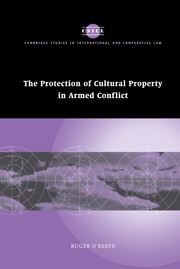Book contents
- Frontmatter
- Contents
- Acknowledgements
- Table of cases
- Table of treaties and other international instruments
- List of abbreviations
- Prologue
- 1 From the high Renaissance to the Hague Rules
- 2 1914 to 1954
- 3 The 1954 Hague Convention and First Hague Protocol
- 4 The 1977 Additional Protocols
- 5 The 1999 Second Hague Protocol
- 6 Other relevant bodies of law
- Epilogue
- Bibliography
- Index
- CAMBRIDGE STUDIES IN INTERNATIONAL AND COMPARATIVE LAW
4 - The 1977 Additional Protocols
Published online by Cambridge University Press: 28 July 2009
- Frontmatter
- Contents
- Acknowledgements
- Table of cases
- Table of treaties and other international instruments
- List of abbreviations
- Prologue
- 1 From the high Renaissance to the Hague Rules
- 2 1914 to 1954
- 3 The 1954 Hague Convention and First Hague Protocol
- 4 The 1977 Additional Protocols
- 5 The 1999 Second Hague Protocol
- 6 Other relevant bodies of law
- Epilogue
- Bibliography
- Index
- CAMBRIDGE STUDIES IN INTERNATIONAL AND COMPARATIVE LAW
Summary
After decades of calls for reform, 1974 saw the opening in Geneva of the Diplomatic Conference on the Reaffirmation and Development of International Humanitarian Law Applicable in Armed Conflicts. Three years later, the conference adopted two new instruments, framed as optional protocols supplementing the 1949 Geneva Conventions. Additional Protocol I, dealing with international armed conflicts, and Additional Protocol II, dealing with their non-international counterparts, codified and, in many respects, progressively developed the modern laws of armed conflict.
Both Protocols embody brief provisions relating specifically to cultural property, which prohibit attacks against it, prohibit its use in support of the military effort and, in the case of international armed conflict, prohibit making it the object of reprisals. They do so, moreover, without exception for military necessity – a notable departure, as regards attacks against and military use of such property, from the situation under the 1954 Hague Convention. That said, the Protocols' relevant provisions are stated to be without prejudice to the Convention, with the result that High Contracting Parties to both are not prevented from availing themselves of the waiver in respect of military necessity embodied in article 4(2) of the Convention.
In addition, and in practice of far greater significance to the wartime fate of cultural property, Protocol I remedies, at least in theory, the three cardinal reasons for its past destruction in bombardment.
- Type
- Chapter
- Information
- The Protection of Cultural Property in Armed Conflict , pp. 202 - 235Publisher: Cambridge University PressPrint publication year: 2006

